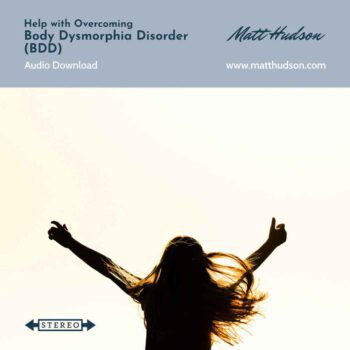Body Dysmorphia Disorder (BDD)
£29.99
– Designed for anyone who wants to overcome BDD
– A powerful aid to self-hypnosis
– Hemi-Sync® audio production
– Creates a calming mental state that accelerates natural healing
– Stimulates the release of dopamine, oxytocin, serotonin and endorphins
– An essential part of your recovery toolkit
Description
What is body dysmorphia/body dysphoria definition?
Body dysmorphic symptoms
The symptoms of BDD are a constant pre-occupation or focus on a particular part of your body, that other’s hardly notice. You may believe that you have been born deformed as the body you see is influenced by what you perceive. This distorted view of the outside world can lead to a negative spiral as you believe others are pointing at you and talking about your ugly physical floor.
Body dysmorphic disorder causes (BDD)
Studies into adverse childhood experiences (ACE’s) highlight that many of us suffer adversity at an early age. If we view body dysmorphia through a psychophysiological lens, then it becomes easier to see where the origins of BDD may lie. Other probable causes are listed below but they still remain within the psychological (mind) and physiological (body) remit:
- abuse or bullying.
- low self-esteem.
- fear of being alone or isolated.
- perfectionism or competing with others.
- genetics.
- depression, anxiety or OCD.
Please note that genetics is also influenced by the way that we think.
How do you know if you have body dysmorphia?
What causes body dysmorphia?
Do I have body dysmorphia or am I just insecure?
How do you fix body dysmorphia?
Treatment for body dysmorphic disorder
Hypnotherapy for body dysmorphic disorder
Can hypnosis help with body dysmorphic disorder
My Audio Download
BDD is a mental condition that affects both men and women equally. BDD involves a person’s excessive concern over specific parts of their body. Thoughts of a person’s imperfections become obsessive and can take up hours of their day.
This audio production is designed to help the listener overcome BDD. By clearing negatively charged Emotional Memory Images from your external screen, your mind and body are able to adapt to the present moment, allowing you to enjoy life free of limiting subconscious patterns. This audio is your own personal 1 to 1 session with Matt, always available at your convenience.
Matt’s calming, assuring voice gently guides both your conscious mind and unconscious mind towards healing through the left and right ear respectively. By tapping into the body’s psychoneuroimmunilogical mechanisms – the link between the mind, nervous system and physical wellbeing – this audio promotes enhanced mental balance and a healthy self image.
For best results, listen to this audio download first thing in the morning or during the day, every day for 4 weeks. Ensure you’re free from interruptions and distractions when listening. Download now to start overcoming BDD today.
This audio is a .MP3 file, compatible with smartphones, tablets, PC’s and other electronic devices.
Audio length: 30 minutes.




